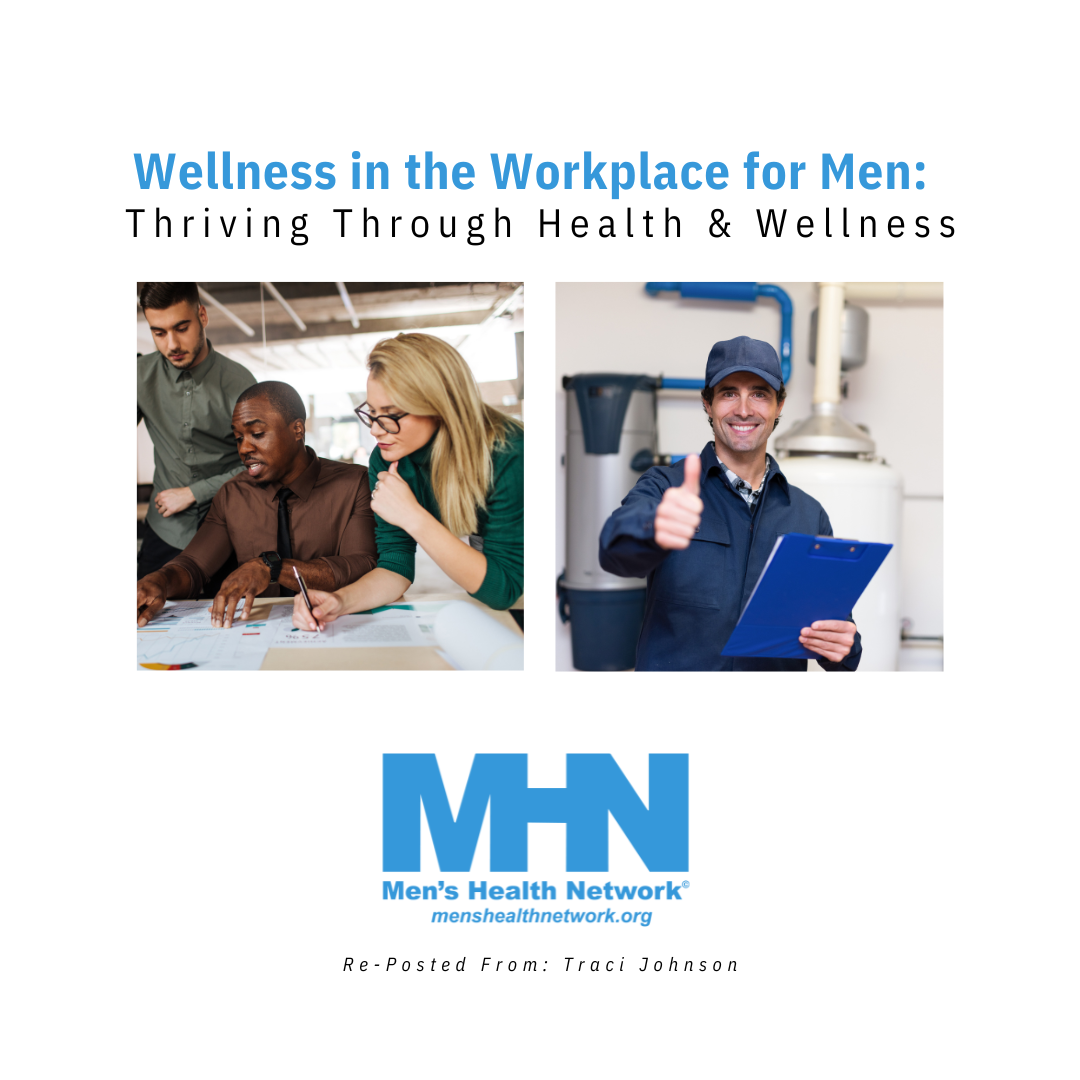Wellness in the Workplace for Men:
Thriving Through Health & Wellness
As we have stated in previous articles, employees spend more than one-third of their lives at work, which makes the workplace the perfect arena for workers to get evidence-based healthcare information designed to improve health and make healthcare services more accessible.
Many organizations provide Chronic Care Management or Disease Management Programs to their employees to raise awareness of and prevent or halt the onset of chronic disease. Chronic
disease is pervasiveness and negatively impacts an individual’s life at home and work.
Organizations are more mindful than ever that the health of their employees is directly tied to productivity and profit margins:
healthy employees = healthy profits.
Healthcare Treatment Approaches
With June being Men’s Health Awareness Month, it’s a great time to reflect on men’s unique health challenges.
Extensive research has shown that men and women approach health, healthcare, and health maintenance differently. According to Harvard University Medical School, on average, men pay less attention to their health than women, as is evidenced by the fact that men are 50% less likely to seek healthcare of any kind.
This statistic is a real cause for concern when you consider that men drink more alcohol, smoke more, and are more prone to risky behaviors (driving without seatbelts, motorcycle use without a helmet, or unprotected sex, to name a few.), all of which can cause unnecessary debility and death, per The Health Policy Partnership Organization.
Men’s divergent approaches to healthcare are often attributed to the media, which, conscientiously or not, perpetuate advertisements that portray masculinity or maleness as invincibility, indestructibility, and without the need for healthcare, preventive or otherwise.
These advertisements propagate the notion that the only legitimate time a man should seek healthcare is for a condition or illness that attacks or insults his sexual prowess or virility.
This flawed perception of masculinity undermines the health of men.
It puts men’s lives at risk by discounting how powerful healthcare management is at identifying conditions that respond well to treatment and help prevent needless pain, discomfort, or death.
Understanding Chronic Disease The CDC (Centers for Disease Control and Prevention) defines a chronic disease or condition as one that lasts one (1) year or more, requires ongoing medical attention, and limits activities of daily living or both.Chronic diseases are the leading cause of death and disability in the US and cost approximately $4.5 trillion annually to treat.
Risk behaviors are the causes of many chronic conditions, and the CDC identifies these risk behaviors as ones that are the most insidious on physical health.
These behaviors are easily identifiable but difficult for many people to overcome. They are:
• smoking
• poor nutrition
• physical inactivity
• excessive alcohol use
There are also non-medical factors that may cause a person to get sick. These non-medical factors are called Social Determinants of Health (SDOH). SDOHs relate to conditions in which a person is born, lives, learns, works, plays, and/or worships. When the adverse effects of SDOHs are present, along with physical risks, a person has an even greater chance of becoming sick. SDOHs limit the chances and opportunities people have to recognize or make appropriate health choices or to get good health care.
Following are some of the most common health conditions that affect men’s health and quality of life and can also potentially decrease their expectancy:
Hypertension
Research shows that men have higher levels of high blood pressure than women. Hypertension is a severe disease that causes the heart to work harder to pump blood through narrowed arteries. As many as 20% of those with hypertension don’t even know they have it. High blood pressure is the leading cause of cardiovascular (heart) disease, stroke, and kidney failure. Men with untreated hypertension are twice as likely to develop Erectile Dysfunction. In addition, research also shows that men have lower health literacy about hypertension than women.
Type 2 Diabetes
According to the CDC, men are more likely to develop type 2 diabetes at a lower weight than women. This is thought to be because men are more prone to store fat in their abdomens —which is a known risk factor. Also, those with Type 2 diabetes are more likely to develop heart disease, stroke, vision loss,
kidney failure, and even amputation of a toe, foot, or leg, as well as being a cause of Erectile Dysfunction (ED).
Lung Cancer
The American Cancer Society says men have a 1 in 16 chance of developing lung cancer in their lifetime, and this number increases substantially for those who are or have been smokers. Lung cancer is the leading cause of all cancer deaths, accounting for 20% of cancer-related deaths. More people die from lung cancer each year than those with colon, breast, and prostate cancer combined.
Prostate Cancer
Prostate cancer is the second leading cause of death in American men, after lung cancer. The American Cancer Society says that 1 in 44 men will die of prostate cancer. The most favorable fact about prostate cancer is if it is caught early, it has a high rate of being successfully treated, and most men who are diagnosed with prostate cancer do not die from it.
Alcoholism
Per the CDC, Almost 58% of US men report drinking alcohol in the past 30 days. In addition, 21% of all US males who drink are binge drinkers, and 13% of these drinkers are diagnosed with Alcohol Use Disorder. Men are 50% more likely to have been intoxicated when they were or are in motor vehicle accidents. Excessive alcohol consumption increases the chances of aggression and the risk of physically assaulting another person. Men who are dependent on alcohol are 6-7 times more likely to be perpetrators of domestic violence against women and children, and it interferes with testicular function and male hormone production, which are the leading causes of ED and infertility in men.
Men with alcohol abuse disorder are more likely to develop depression.
They are three times more likely to die by suicide.
Alcohol abuse disorder increases the likelihood of liver cirrhosis
Depression
Men typically experience depression differently from women. Men with depression symptoms tend to present as angry or aggressive instead of sad. Men are less likely than women to talk about or seek treatment for their depression. Men who are depressed commit suicide four times more than women. Even though women attempt suicide more often, men are more successful in completing suicide because they use more lethal means such as firearms, hanging, or asphyxiation. Gay, bisexual, and transgender men are more likely to be depressed and attempt suicide. Minority gay, bisexual, and transgender men are twice as likely to be depressed and five times more likely to attempt suicide.
Domestic Violence
Another taboo healthcare subject for men has to do with domestic violence. While it is true that women, children, and the elderly are the primary victims of domestic violence, men can also be victims. While research shows that gay, bisexual, or transgender men have a high rate of abuse, that doesn’t mean that straight men aren’t also victims of domestic abuse. 1 in 9 straight men and 26% of gay, bisexual, or transgender men are victims of domestic violence. For obvious reasons, many men are reluctant to talk, being victims of abuse. No matter your gender or sexual preference, domestic violence is an insidious crime, and we must be more vocal and do all we can to call more attention to it. Just like for Women’s Health Month, I am attaching a National Resource List For Domestic Violence Victims.
Please feel free to print this resource list and distribute it to as many people as you can; you never know when you or someone you know or love will need it.
Health Education, Health Literacy and Preventative Care
Ben Franklin is credited with the axiom: “An ounce of prevention is worth a pound of cure.”
We know so much more now about the significance of preventative health and how Ben’s axiom is perfect in this instance. According to HealthCare.gov, preventative health care is a proactive approach to disease management that includes screenings, vaccines, check-ups, follow-ups, and care management to prevent illness, disease, or other health problems. It allows people to live life a better quality of life by preventing or decreasing the pain, discomfort, or infirmities that come from chronic diseases.
Health education and health literacy go hand in hand with preventative healthcare; they all work together to help you better understand your health, your healthcare options, and which healthy behaviors can decrease or prolong the chances of getting chronic diseases. Health education, literacy, and preventative care can also help lower your chances of getting severe illnesses from some infectious diseases, like the flu and COVID-19.
No matter how much health education and literacy you receive or how many healthy behaviors you adopt, they will only be successful to a point; without routine preventive care and screenings, which help you stay well and catch problems early, you may miss out on the opportunity to have a better, happier, and longer life.




